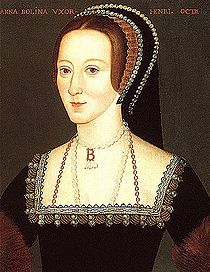Last week, I talked about the lies surrounding Anne Boleyn and her appearance and how historical evidence was now questioning the picture of Anne as a woman with six fingers on one hand, goitre and a wart.
So, what was Anne really like?
Anne Boleyn – A Beauty?
 As I said last week, Anne’s enemies destroyed likenesses and portraits of Anne, so it is hard for us to know conclusively what she looked like. However, this famous portrait of her, that we all know and love, is said to be a copy of an original.
As I said last week, Anne’s enemies destroyed likenesses and portraits of Anne, so it is hard for us to know conclusively what she looked like. However, this famous portrait of her, that we all know and love, is said to be a copy of an original.
There are various quotes which talk of Anne’s looks:-
“beautiful and with an elegant figure” – Lancelot de Carles, quoted in “The Life and Death of Anne Boleyn”, Eric Ives
Anne “was very eloquent and gracious, and reasonably good looking” – John Barlow, a cleric of Anne, also quoted in Eric Ives’ biography.
“Young and good-looking” – Simon Grynee, “Original Letters”
“Very beautiful” – Francesco Sanuto, Venetian Diplomat, who also described her as “swarthy” or dark-skinned.
“…eyes always most attractive which she knew well how to use with effect. Sometimes leaving them at rest and at others, sending a message to carry the secret witness of the heart. And, truth to tell, such was their power that many surrendered to their obedience” – Lancelot de Carles.
“She was handsome to look at, with a pretty mouth”, Nicholas Sander in “The Rise and Growth of the English Schism” after also describing her ugliness!
Eric Ives in his biography says that history points to Anne having “tolerable” looks, not beautiful but certainly not plain or ugly, and having a “splendid head of dark hair and fine eyes”. Some historians talk of her having rich auburn hair, which she inherited from her father.
More Evidence
A surviving 1534 portrait medal which carries the initials A.B. and Anne’s motto “The Moost Happi” shows a woman with a long oval face and high cheekbones.
An enamel portrait from a ring thought to have belonged to Elizabeth I, Anne’s daughter, also shows a woman with a long oval face, high cheekbones and other features like a “decided” chin and strong nose. These striking looks would have been inherited from her beautiful mother, Elizabeth Howard, and would have been a contrast to the usual blonde, blue-eyed stereotype of beauty.
From these two surviving pictures, it is clear that Anne was not an obvious beauty, but her striking facial features combined with her evident charm, wit and intelligence would have made her stand out from the crowd – she certainly caught Henry’s eye!
I went to the British Museum today to visit the Moost Happi medal :>)
The craftsmanship is It is exquisite, and so fine that my eyes ached after staring at it, even with a magnifying glass.
Definitely a ‘decided’ chin and a strong and determined smile. I am so glad that the one contemporary portrait of her (that everyone can agree on) is as ‘the moost happi’. That is the image of Anne that I always want to keep in mind.
With regards to Anne’s hair colour – where is it first written that she had dark brown/ black hair?
Queen Eliabeth 1′ commissioned a ring bearing her mothers portrait. Here, her hair is made from gold. Even taking into account the limited range of colours available to the jeweler, surely if her mother’s hair had been dark the jeweller would have used the black ennamel for her hair, not for her headdress?
What do you think?
Annes beauty came from her ability to make the best of what she had, and I think most of that was learnt in the French court. She did not have the favoured colouring of the time, which was fair haired and blue eyed so she brought out her natural attractiveness with her attension to fashion, leading the way with new designs, wearing clothes that flattered her body and colouring. This was backed up with her intellect,language skills,quick wit,and confidence. She was athletic, musical, ( being able to play many instruments), and danced gracefully. Her social graces were well polished and french like, which added refinement that would have been notice in the ‘slighty rough around the edges’ english court. You add all that together and you have one stunning lady. Maybe not natually beautiful, but beautiful all the same. After all beauty is in the eye of the beholder, and Henry’s eye certainly thought so, much to her destruction. I sometimes think that there is too much emphasis put on wheather or not she was a physical beauty and not enough on the person as a whole.
Lucy – with regard to the brown/black hair, one of the most interesting pieces of evidence is Anne’s “name” in a poem to her by Thomas Wyatt. It was fashionable at the time to give your sweetheart a false name to refer to them in your poetry, and Anne’s was “brunet”. It literally means “little dark-haired girl from France” and was probably first ever use of the word (the next documented use was 1705).
With regard to the gold hair, it is probable that the jeweller wanted to paint her as the traditional Tudor beauty, i.e. blonde, blue-eyed, etc. We also can’t be sure that the ring in question belonged to Elizabeth I, though it is likely.
Hope this helps 🙂
Tiula – a belated thanks for your response! I didn’t know that the term ‘brunet’ was probably used for the first time in Thoma Wyatt’s poem. It’s a lovely thought :>)
Many thanks, Lucy